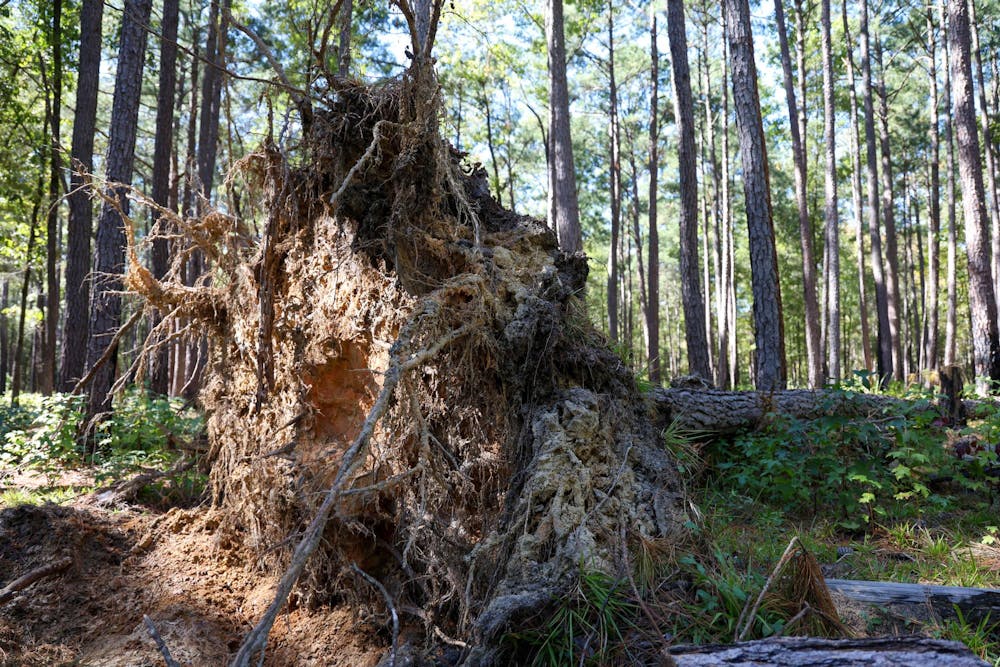A month ago, Hurricane Helene hit Columbia and Congaree National Park. The local area was affected by river flooding, fallen trees and power outages, creating problems for people in the community in the aftermath of the storm.
The park was closed for one week following the storm due to power and water outages and had issues with fallen trees and minor flooding, Chief of Visitor Services at Congaree National Park Jon Manchester said. He said Hurricane Helene did not cause an abnormal amount of damage.
"So, in even a good thunderstorm, we'll get trees that come down, and a storm like Helene will probably have more than what we would get near standard storm," Manchester said.
Park rangers evaluate the damage caused by storms and determine their course of action.
“We let the natural condition remain as it is, unless there’s a health, life and safety component to that,” Manchester said.
Species of trees like Bald Cypresses and Water Tupelo that are prominent in the park have adapted to the floodplain by growing deeper roots, which helped to minimize damages from flooding. Trees that have shallower roots are more likely to fall, he said.
Wildlife, like the species of trees, have adapted to prepare for storms like Helene, Manchester said.
“So, this flood kind of followed a more normal progression of a flood, so the animals that are out in the floodplain, they kind of know what they are looking for, and so they’ll start making their way to high ground,” Manchester said.
The South Carolina Department of Natural Resources put a hunting closure within the Santee, Wateree and Congaree water basins, he said. The closure for the Wateree and Congaree areas lasted from Oct. 2 to Oct. 6. according to the South Carolina Department of Natural Resources.
Flooding caused the deer to be pushed to higher ground, creating an unfair advantage for certain areas of this closure. Hunting is not permitted within the park, but there are hunt clubs for the edges of the park, Manchester said.

A sign reading "HABITAT RESTORATION IN PROGRESS" and "PLEASE STAY ON THE DESIGNATED TRAIL"" hangs near the trail at Congaree National Park on Oct. 20, 2024. Several parts of the trail required navigating around fallen trees and flooded paths.
The floods from Helene came within one-hundredth of a foot of the historic 2015 levels, he said.
“In 2015, we got upwards of 20 inches of rain in our area,” Manchester said. “And so once one dam upstream fails, if there’s more downstream, it’ll eventually cause those to fail too.”
Congaree National Park sits on a natural floodplain. When water from the Congaree River flowed into the floodplain, it was stored there and the flooding was slowed, he said.
Standing water is an issue because it is not easy to get rid of, said Alicia Wilson, a professor in the School of Earth, Ocean and Environment with research specializing in hydrogeology.
"It's going to take a while for it to drain because it's groundwater. You can't just drain into this hole and have it go away," Wilson said.
The route of the hurricane is a factor that contributed to the effects in the park.
Hurricane Helene was passed over the Gulf of Mexico and gained size due to warmer than average water temperatures, professor of geography Greg Carbone said.
The warmth of the water can cause hurricanes to inflict more damage to the mainland due to faster wind speeds, Carbone said.
“So, you have a situation where global climate change is altering the ocean temperatures. And that additional energy means that when a hurricane forms in that environment, it is likelier to cause more damage in the way of wind speed, hurricane surge, heavy precipitation and ultimately flooding,” Carbone said.
On the right side of a hurricane, the wind speed is faster due to the speed of the storm's rotation being added to the speed of the storm's movement forward. However, on the left side of the storm, wind speed is slower because the it is moving in the opposite direction. The bigger the storm is, the faster and stronger the wind speed will become.
"Congaree is far enough east that the wind speeds are quite diminished, compared to (Aiken and Augusta), and even lower than Columbia itself," he said. "The rotation of the storm brought the faster speeds to the cities closer to the eye of the storm. Because Congaree is on the outside, it avoided much of the damages seen in the other areas."
Congaree National Park remains open to visitors following the storm 24 hours every Monday–Sunday. Visitor Center hours may vary. Guests can learn more about the state of the park on the National Park Service website.

